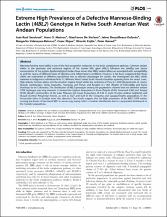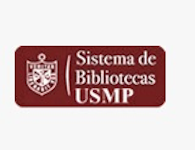Mostrar el registro sencillo del ítem
Extreme High Prevalence of a Defective Mannose-Binding Lectin (MBL2 ) Genotype in Native South American West Andean Populations
| dc.contributor.author | Sandoval Sandoval, José Raul | |
| dc.contributor.author | Madsen, Hans O. | |
| dc.contributor.author | De Stefano, Gianfranco | |
| dc.contributor.author | Descailleaux-Dulanto, Jaime | |
| dc.contributor.author | Velazquez Reinoso, Margarita Rosa Eugenia | |
| dc.contributor.author | Ñique Carbajal, César | |
| dc.contributor.author | Fujita, Ricardo | |
| dc.contributor.author | Garred, Peter | |
| dc.creator | Ñique Carbajal, César | |
| dc.date.accessioned | 2016-03-10T15:58:53Z | |
| dc.date.available | 2016-03-10T15:58:53Z | |
| dc.date.issued | 2014 | |
| dc.identifier.citation | Sandoval JR, Madsen HO, De Stefano G, Descailleaux-Dulanto J, Velazquez-Reinoso M, et al. (2014) Extreme High Prevalence of a Defective Mannose- Binding Lectin (MBL2 ) Genotype in Native South American West Andean Populations. PLoS ONE 9(10): e108943. doi:10.1371/journal.pone.0108943 | es_PE |
| dc.identifier.uri | https://hdl.handle.net/20.500.12727/1530 | |
| dc.description.abstract | Mannose-binding lectin (MBL) is one of the five recognition molecules in the lectin complement pathway. Common variant alleles in the promoter and structural regions of the human MBL gene (MBL2) influence the stability and serum concentration of the protein. Epidemiological studies have shown that MBL2 variant alleles are associated with susceptibility to and the course of different types of infectious and inflammatory conditions. However, it has been suggested that these alleles are maintained in different populations due to selected advantages for carriers. We investigated the MBL2 allelic variation in indigenous individuals from 12 different West Central South America localities spanning from the desert coast, high altitude Andean plates and the Amazon tropical forest within the territories of Peru (n = 249) (Departments of Loreto, Ucayali, Lambayeque, Junin, Ayacucho, Huancayo and Puno), and Ecuador (n = 182) (Region of Esmeraldas and Santo Domingo de los Colorados). The distribution of MBL2 genotypes among the populations showed that the defective variant LYPB haplotype was very common. It showed the highest frequencies in Puno (Taquile (0.80), Amantani (0.80) and Anapia (0.58) islander communities of the Lake Titicaca), but lower frequencies of 0.22 in Junin (Central Andean highland) and Ucayali (Central Amazonian forest), as well as 0.27 and 0.24 in the Congoma and Cayapa/Chachis populations in the Amazonian forest in Ecuador were also observed. Our results suggest that the high prevalence of the MBL2 LYPB variant causing low levels of functional MBL in serum may mainly reflect a random distribution due to a population bottleneck in the founder populations. | es_PE |
| dc.description.sponsorship | The Novo Nordisk Research Foundation, The Benzon Foundation, the Danish Medical Research Council, The Svend Andersen Research Foundation, The Research Foundation of the Capital Region of Denmark and Rigshospitalet. | es_PE |
| dc.format.extent | 7 p. | es_PE |
| dc.language.iso | eng | en_US |
| dc.publisher | PLOS ONE | es_PE |
| dc.relation.ispartof | urn:issn:1932-6203 | |
| dc.relation.ispartofseries | PLOS ONE;vol. 9, n. 10 | |
| dc.relation.uri | http://journals.plos.org/plosone/article?id=10.1371/journal.pone.0108943 | en_US |
| dc.rights | info:eu-repo/semantics/openAccess | es_PE |
| dc.rights.uri | https://creativecommons.org/licenses/by/4.0/ | es_PE |
| dc.source | Universidad de San Martín de Porres – USMP | es_PE |
| dc.source | REPOSITORIO ACADÉMICO USMP | es_PE |
| dc.subject | Lectina de unión a manosa | es_PE |
| dc.subject | Lectina de unión a manosa/análisis | es_PE |
| dc.subject.ddc | 576.5 - Genética | es_PE |
| dc.title | Extreme High Prevalence of a Defective Mannose-Binding Lectin (MBL2 ) Genotype in Native South American West Andean Populations | |
| dc.type | info:eu-repo/semantics/article | es_PE |
| thesis.degree.name | Medicina Humana | es_PE |
| thesis.degree.grantor | Universidad de San Martín de Porres. Facultad de Medicina Humana | es_PE |
| thesis.degree.discipline | Medicina | es_PE |
| dc.identifier.doi | http://dx.doi.org/10.1371/journal.pone.0108943 | |
| dc.subject.ocde | https://purl.org/pe-repo/ocde/ford#3.02.00 | es_PE |
Ficheros en el ítem
Este ítem aparece en la(s) siguiente(s) colección(es)
-
Artículos [274]








